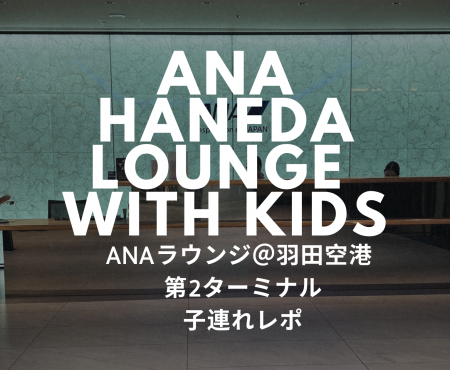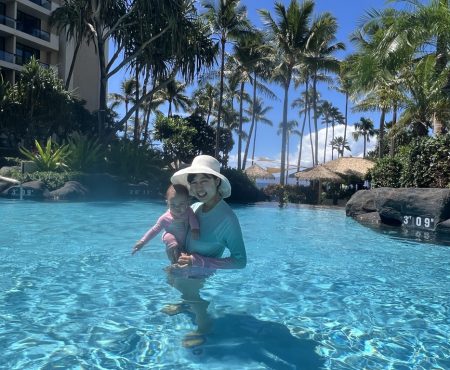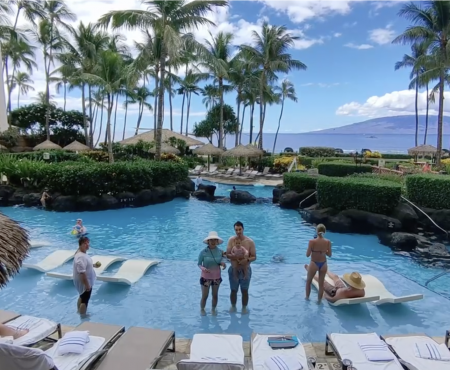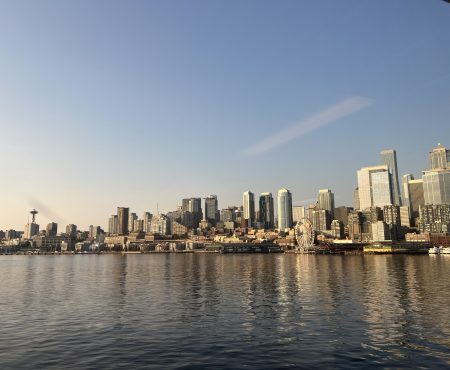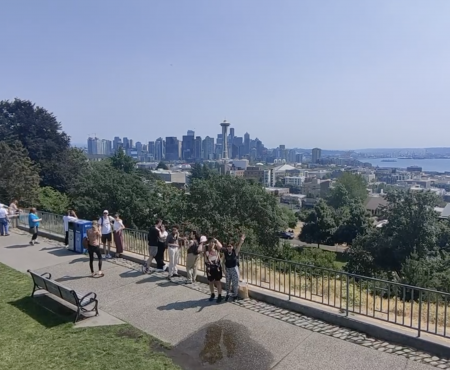
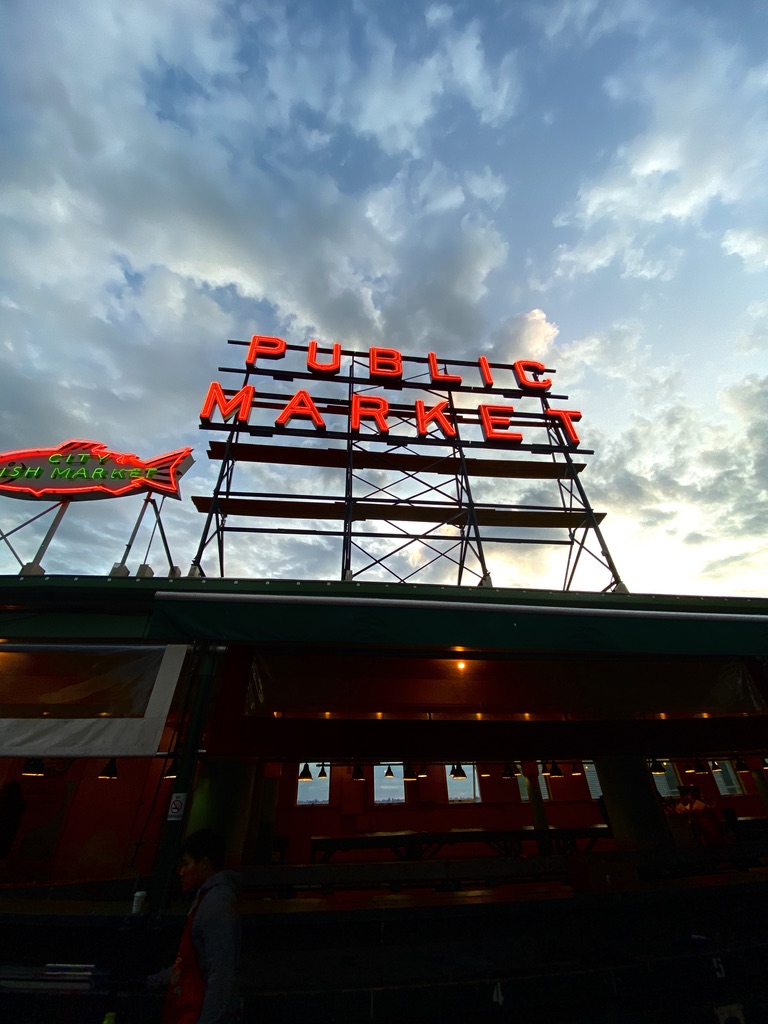
Last weekend, my husband, our 1-year-old daughter, and I embarked on a food tour of Seattle’s iconic Pike Place Market. We joined the “Discover Hidden Gems Tour” hosted by Show Me Seattle. Hidden Gems, as the name suggests, focuses on introducing participants to lesser-known, local favorites that aren’t typically on tourists’ radars.
Even though we’ve been to Pike Place Market countless times, and my husband has been going since he was a child, we learned so much that was new to us.
One of the most surprising discoveries was the market’s Japanese roots. We learned that it was actually founded in 1907 by five Japanese American farmers, making it the oldest continuously operating farmers’ market in the United States. Its popularity grew, and soon, many more farmers began contributing to the market’s success. However, during World War II, Japanese Americans were sent to internment camps, and the market, which was two-thirds Japanese at the time, was forced to close. After the war, it reopened, but faced another threat of closure in the 1970s when there were plans to demolish it and build a hotel. Thanks to the efforts of local residents and donations, the market was saved and has since become a world-renowned tourist destination.
It’s fascinating to note that, even today, there are no Japanese-owned businesses remaining in the market. A mural near the entrance depicts the history of Japanese Americans in the market, but somehow, we’d never noticed it before.
The forced internment of Japanese Americans is a dark chapter in American history, with many historical sites in Seattle and Bainbridge Island serving as reminders of this event. It’s heartbreaking to think about the hardships faced by those Japanese Americans who had just started to build successful businesses in the market. Thanks to their sacrifices, I, as a Japanese person living abroad, have benefited from the stereotype of Japanese people being hardworking and diligent. While I haven’t experienced any major advantages, I’ve never faced discrimination or been treated negatively because of my nationality.
Knowing the history of the market makes walking through it feel even more special. It’s amazing to think that a place I’ve visited so many times has such deep roots in Japanese American history.
Pike Place Market is always bustling with activity, mostly tourists but also locals like us who come for groceries. It’s incredible that the market has never closed except during the pandemic.
Now, back to the tour. Our guide, Woody, was fantastic. He expertly navigated the crowded market on a Friday afternoon, ensuring a smooth and enjoyable experience for everyone. His knowledge of the market’s history was impressive, and he had a knack for engaging with each participant. I learned a lot from his guiding style.
The food tastings were delicious, but the portions were just right. We visited eight different stalls, including some well-known ones and a few hidden gems. The portions were small enough to savor each flavor without feeling overly full.
The pace of the tour was perfect for adults. Woody timed everything perfectly, ensuring we had enough time at each stop without feeling rushed.
While the tour is definitely enjoyable for babies, I would say it might be a bit challenging for toddlers. We brought our 1-year-old daughter and she was fine because she had a nap right before the tour. However, older toddlers who are already walking might find it difficult to stay still for long periods. The tour involves a lot of walking, and while there’s one stop where we could sit for about 15 minutes, it’s mostly standing. Also, baby strollers might be difficult to maneuver in the crowded market. We used a baby carrier, which was much more convenient.
Comfortable shoes are a must! The tour covers a lot of ground, including stairs and hills. Seattle is known for its hills and rain, so I always wear sneakers or flats.
Overall, I highly recommend this food tour. It was a delicious and informative way to experience Pike Place Market.
先日、夫・私・1歳の娘でシアトルのパイクプレースマーケットのフードツアーに参加いたしました。
Show me Seattleの「ディスカバー・ヒドゥン・ジェムズ・フードツアー Discover Hidden Gems Tour」というものです。Hidden Gemsとは、地元の人しか知らないような穴場のお店をたくさん紹介という、ツアー。普通は観光客向けだ。
でも何十回も訪れている私も、それ以上に子供の頃から訪れている夫でさえも、知らない内容がいっぱいあった。
今回本当にびっくりしたのは、実はパイクプレイスマーケットは日系人の農家5軒が始めたということ。1907年、アメリカ最古の現存する市場(マーケット)だそう。それが好評で、どんどん毎週みんな農家が多くの持ってきてこのような大規模なマーケットになったんだそうです。
それが第二次世界大戦で、日本人移民キャンプに強制収容されると、日系人が3分の2だったマーケットは一度クローズに。
そして戦後再開され、その後1970年代にも取り壊されそれてホテルになりそうな時も、地元民の希望と寄付で残すことを決めて、今では世界中の観光客が訪れる場所になっている。
今もなお日本人移民の店は0だそう。
その日系人の歴史が、なんと入り口のところに切り絵と供に描かれていたのですが、私たちも何十回もきているのですが全く気付きませんでした。
*日本人移民の強制収容はシアトルやベインブリッジ島のいろんなところに歴史として残っています。
せっかくパイクプレイスマーケットでビジネスを成功させ始めていた彼らのどれだけ無念だったことか。
でもその先祖のおかげで、今も私は「日本人」というだけで真面目で働き者というイメージの恩恵を多少なりとも受けてこうやって海外で生活してるので、先人には感謝ですね。別に超絶メリットを受けたわけでもないけど、少なくとも日本人と言って嫌がられたこと、差別を受けたことは全くないです。
多分パイクプレイスマーケットの繁栄も、まさか日本人が始めたとは全く知らなかったので、なんだか近くを歩くたびにちょっと嬉しくなりますね。
パイクプレイスマーケットは本当に大繁盛。
ほとんどはまあ観光客だとは思いますが、近所の我らも食べ物買いに行ったりたまにします。
コロナ以外で閉鎖した日はないとのこと。
今日も元気に賑わっています。
さて、ツアーの内容に戻ると
知識豊富で親切なガイド:
私たちのガイドを務めてくれたウッディさんが素晴らしかった!金曜午後だったのでかなり混雑したマーケットの中でも私たちを導き、混乱がないようにツアーを2時間していました。マーケットの歴史について彼の説明が上手でちゃんと聴いてられる。歩く合間には、参加者一人ひとりに話しかけて丁寧に会話をしてくれる姿にも感心しました。私もガイドをすることがあるので学ぶことが多いなあと思ってみていました。
量はそんなに多くない
ツアーでは、彼の厳選された8軒の店で試食を楽しむことができます。人気の店で何度も行ったこともある店もあれば、こんなところに!というお店もありました。ただ量はそこまで多くない。パンは小ぶりのものが一つずつですが、他の店は5ー10口サイズかな。一口サイズではなく、それぞれの店の味をじっくり味わえるほどの量はあります。
ペース配分は大人にちょうどいい
ガイドが、皆がそれぞれの試食を充分に楽しめるように、完璧なタイミングで次の場所へ移動してくれました。早すぎることも遅すぎることもなく、すごい。
ベビー連れでも楽しめるけど、幼児は難しい?
今回は 1歳の下の娘と一緒に参加しました。ベビーでも大人のものを食べれるようであれば、ツアー自体は楽しむことができます。うちの娘は直前に昼寝していったので、ずっとご機嫌でした!ただし、このツアーは主に歩きのツアーで、座れる場所は限られています。最後のレストランでは15分ほど座ることができましたが、もう少し大きい、歩けるようになった幼児だとずっと抱っこも厳しいだろうし、歩き回りたくなりますよね。それは厳しいかも。
ちなみにベビーカーも難しい!狭い道や混雑した場所や階段、坂、裏などいろんなところを歩くので、ベビーカーは事前に連絡してと書いてありました。私たちは抱っこ紐で言って正解。こういう時ヒップシートありの抱っこ紐は本当に助かります。
歩きやすい靴は必須!
ツアーは約2時間続き階段や坂もあります。
もともと坂や雨の多いシアトル。私はもう、スニーカーやフラットシューズしか履いてません。
ほんと満足でした!
美味しかったご飯、どこで食べたかはぜひこの動画に載せたので見てみてね!

